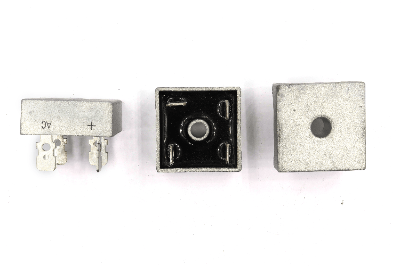What Is a Rectifier?

A rectifier is a device that rectifies current using semiconductor elements.
Rectification is the conversion of alternating current to direct current and is produced by utilizing the property of diodes, etc., to conduct current in only one direction.
Uses of Rectifiers
Rectifiers are widely used to supply DC power.
Familiar examples are AC adapters for supplying power to PCs and smartphones. In industrial applications, they are used for large motor control and electrolysis. Rectifiers, such as thyristors, have long been used for motor control.
Trains are typical machines powered by DC motors and have been fed with rectifiers. In recent years, speed control of AC motors has become common, and trains powered by AC motors have become widespread on train lines. Inverters that control the speed of AC motors use semiconductors called bipolar transistors or IGBTs.
Principle of Rectifiers
Rectifiers use semiconductors to convert AC power into DC power. There are various types of semiconductors, including diodes that conduct current in only one direction and thyristors that conduct current only when a signal arrives at the gate.
All of these semiconductors are made by a pn junction combining p-type and n-type semiconductors and utilize the energy level difference between the semiconductors.
Other Information on Rectifiers
1. Semiconductors Used in Rectifiers
Diodes are composed of p-type and n-type semiconductors. p-type semiconductors have a higher energy level than n-type semiconductors. Therefore, p-type holes can easily flow to n-type semiconductors, while n-type electrons have difficulty flowing to p-type semiconductors. As a result, the current flows when the p-side potential is high, while the current does not flow when the n-side potential is high.
The p-side terminal is anode and the n-side terminal is a cathode. A thyristor is composed of semiconductors stacked in the order of p, n, p, n, with the gate terminal taken out from the middle p part. By applying voltage from this gate part to the cathode side, the current can flow from the anode to the cathode.
This is called turn-on. If you want to turn off a thyristor that has been turned on, you can return it to its original state by making the voltage on the cathode side higher than the anode side.
2. Rectifier’s Role in Industry and the Home
Rectifiers have long been used in factories and homes. The electricity used for home landline telephones is DC voltage converted to DC by a rectifier. Rectifiers are also built into AC adapters used to charge computers and smartphones. Rectifiers are always used inside the electronic circuits of inverter air conditioners, which use inverters to control the temperature.
Rectifiers are also widely used in the industry up to the present day. Many DC feeder lines with rectifiers are still in use in trains. Rectifiers are used for electrolytic refining in aluminum plating plants. Some arc furnaces, for example, use DC current, and rectifiers are used as power sources.
Demand for rectifiers is expected to increase in the future. Electric vehicles are loaded with numerous batteries to withstand long-distance driving. Batteries cannot be charged using AC power and must be rectified using a rectifier. Thus, rectifiers play an important role and will continue to be widely used.
3. Voltage of the Rectifier
The supply voltage rectified by the rectifier can be varied to match the source of supply. The voltage rectified by the diode can be varied using a capacitor, reactor, or resistor. However, if the voltage is varied using a resistor, heat losses are generated.
When the voltage is varied, rectifiers using thyristors, or IGBTs are now widely used. This is because the voltage can be continuously varied simply by changing the arc angle.
4. Rectifier Capacitance
Rectifiers are also a part of electrical components and therefore have a current allowance. The allowable current also determines the capacity.
As with wiring and contactor contacts, the larger the size, the larger the capacity of the rectifier. The capacity of a rectifier is determined by the current and voltage values that the individual components can withstand, with the most electrically weakest component determining the allowable value. In general, the capacitance of the rectifier as a whole is often determined by the capacitance of the capacitors to be smoothed.